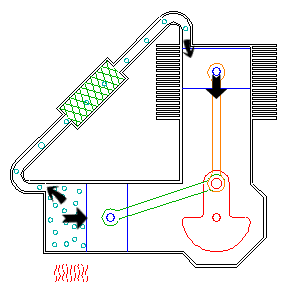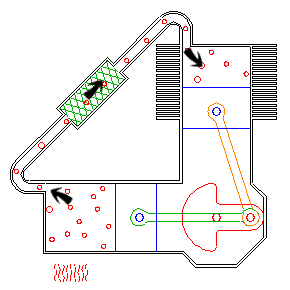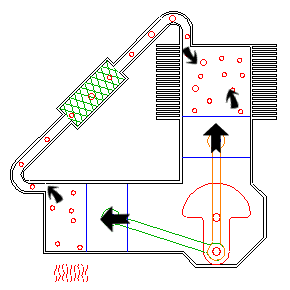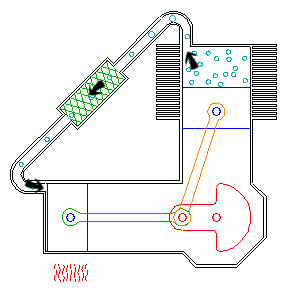Two Cylinder Stirling Engine - Animated Engines
The Stirling engine is one of my favorites. It was invented in 1816 by Rev. Robert Stirling of Scotland. The Stirling is a very simple engine, and was often billed as a safe alternative to steam, since there's no risk of a boiler explosion. It enjoyed some success in industrial applications, and also in small appliances like fans and water pumps, but it was eclipsed by the advent of inexpensive electric motors.3 However, because it can run on any source of heat, it now holds promise for alternative fuel engines, solar power, geothermal power, etc.
Animazione sul sitoStirling engines feature a completely closed system in which the working gas (usually air but sometimes helium or hydrogen) is alternately heated and cooled by shifting the gas to different temperature locations within the system.
In the two-cylinder (or alpha configured3) Stirling, one cylinder is kept hot while the other is kept cool. In this illustration, the lower-left cylinder is heated by burning fuel. The other cylinder is kept cool by air circulating through a heat sink (a.k.a. cooling fins).
The Stirling cycle can be thought of as four different phases: expansion, transfer, contraction, and transfer.
 Expansion
ExpansionMost of the gas in the system has just been driven into the hot cylinder. The gas heats and expands driving both pistons inward.
La maggior parte del gas nel sistema, viene guidato nel cilindro caldo. Il gas si riscalda e si espande guidando tutti e due i pistoni verso l'interno. Transfer
TransferThe gas has expanded (about 3 times in this example). Most of the gas (about 2/3) is still located in the hot cylinder. Flywheel momentum carries the crankshaft the next 90 degrees, transferring the bulk of the gas to the cool cylinder.
Il gas si e' espanso (circa di 3 volte in questo esempio). La maggior parte del gas 2/3 e' sempre localizzato nel cilindro caldo. Il momento del volano trasporta l'albero motore nei successivi 90 gradi, trasferendo gran quantita' del gas nel cilindro freddo. Contraction
ContractionThe majority of the expanded gas has shifted to the cool cylinder. It cools and contracts, drawing both pistons outward.
La maggior parte del gas espanso si e' trasferito nel cilindro freddo. Si raffredda e si contrae, trasportando entrambi i cilindri fuori. Transfer
TransferThe contracted gas is still located in the cool cylinder. Flywheel momentum carries the crank another 90 degrees, transferring the gas to back to the hot cylinder to complete the cycle.
Il gas contratto e' fermo nel cilindro freddo. Il momento del volano trasporta la manovella di altri 90 gradi, trasferendo il gas all'indietro verso il cilindro caldo a completare il ciclo.


